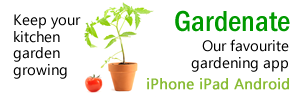Growing Potato
Solanum tuberosum : Solanaceae / the nightshade family
| Jan | Feb | Mar | Apr | May | Jun | Jul | Aug | Sep | Oct | Nov | Dec |
|---|---|---|---|---|---|---|---|---|---|---|---|
| P | P | P | P | P |
(Best months for growing Potato in Australia - temperate regions)
- P = Plant seed potatoes
- Plant tuber. Best planted at soil temperatures between 10°C and 30°C.
- Space plants: 30 - 40 cm apart
- Harvest in 15-20 weeks. Dig carefully, avoid damaging the potatoes.
- Compatible with (can grow beside): Peas, Beans, Brassicas, Sweetcorn, Broad Beans, Nasturtiums, Marigolds
- Avoid growing close to: Cucumber, Pumpkin, Sunflowers, Tomatoes, Rosemary

Your comments and tips